工程项目管理专业英语(下) 汉译英
工程项目管理(双语)
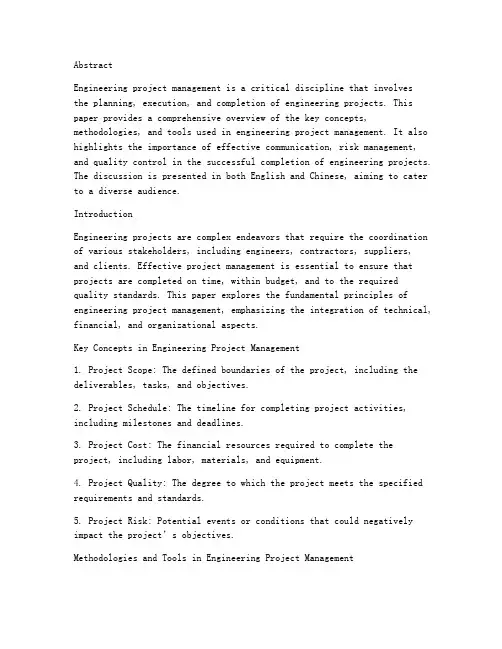
AbstractEngineering project management is a critical discipline that involvesthe planning, execution, and completion of engineering projects. This paper provides a comprehensive overview of the key concepts, methodologies, and tools used in engineering project management. It also highlights the importance of effective communication, risk management, and quality control in the successful completion of engineering projects. The discussion is presented in both English and Chinese, aiming to cater to a diverse audience.IntroductionEngineering projects are complex endeavors that require the coordination of various stakeholders, including engineers, contractors, suppliers,and clients. Effective project management is essential to ensure that projects are completed on time, within budget, and to the requiredquality standards. This paper explores the fundamental principles of engineering project management, emphasizing the integration of technical, financial, and organizational aspects.Key Concepts in Engineering Project Management1. Project Scope: The defined boundaries of the project, including the deliverables, tasks, and objectives.2. Project Schedule: The timeline for completing project activities, including milestones and deadlines.3. Project Cost: The financial resources required to complete the project, including labor, materials, and equipment.4. Project Quality: The degree to which the project meets the specified requirements and standards.5. Project Risk: Potential events or conditions that could negatively impact the project’s objectives.Methodologies and Tools in Engineering Project Management1. Project Planning: The process of defining the project scope, schedule, and resources required to complete the project.2. Project Execution: The implementation of the project plan, including the coordination of resources and activities.3. Project Monitoring and Control: The ongoing assessment of theproject’s progress, performance, and quality, with the aim of making adjustments as necessary.4. Project Closure: The formal completion of the project, including the handover of deliverables and documentation.Key tools and techniques include:- Project Management Software: Tools like Microsoft Project, PrimaveraP6, and Trello help in planning, scheduling, and tracking project activities.- Critical Path Method (CPM): A project scheduling technique that identifies the longest path of activities that determines the project duration.- Risk Management: Identifying, analyzing, and responding to risks that coul d impact the project’s objectives.- Quality Control: Ensuring that the project deliverables meet the specified quality standards.Effective Communication in Engineering Project ManagementEffective communication is crucial in engineering project management to ensure that all stakeholders are aligned and informed. Key communication strategies include:- Regular Meetings: Scheduled meetings to discuss project progress, issues, and decisions.- Progress Reports: Regular updates on the project’s status, includ ing milestones achieved and challenges faced.- Documentation: Comprehensive documentation of project activities, decisions, and changes.- Conflict Resolution: Addressing and resolving conflicts among stakeholders in a timely and constructive manner.Risk Management in Engineering Project ManagementRisk management is a critical aspect of engineering project management. Key steps in risk management include:- Risk Identification: Identifying potential risks that could impact the project.- Risk Analysis: Assessing the likelihood and impact of each risk.- Risk Response: Developing strategies to mitigate, avoid, transfer, or accept risks.- Risk Monitoring: Ongoing monitoring of risks to ensure that mitigation strategies are effective.Quality Control in Engineering Project ManagementQuality control is essential to ensure that the project deliverables meet the specified requirements and standards. Key quality control activities include:- Quality Planning: Defining the quality standards and procedures for the project.- Quality Assurance: Ensuring that the project processes anddeliverables meet the quality standards.- Quality Control Activities: Inspecting and testing the project deliverables to identify and correct defects.ConclusionEngineering project management is a multifaceted discipline that requires a comprehensive understanding of technical, financial, and organizational aspects. Effective project management ensures thatengineering projects are completed on time, within budget, and to the required quality standards. By focusing on key concepts, methodologies, and tools, project managers can successfully navigate the complexitiesof engineering projects and deliver successful outcomes.中文摘要工程项目管理是一个涉及工程项目的规划、执行和完成的跨学科领域。
工程项目管理_中英文
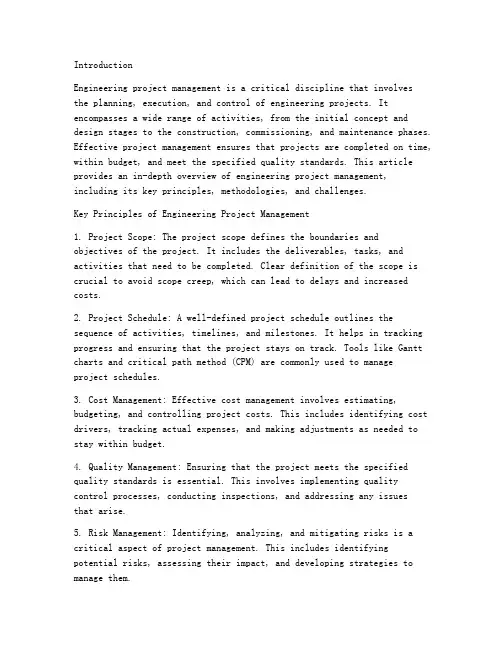
IntroductionEngineering project management is a critical discipline that involvesthe planning, execution, and control of engineering projects. It encompasses a wide range of activities, from the initial concept and design stages to the construction, commissioning, and maintenance phases. Effective project management ensures that projects are completed on time, within budget, and meet the specified quality standards. This article provides an in-depth overview of engineering project management,including its key principles, methodologies, and challenges.Key Principles of Engineering Project Management1. Project Scope: The project scope defines the boundaries andobjectives of the project. It includes the deliverables, tasks, and activities that need to be completed. Clear definition of the scope is crucial to avoid scope creep, which can lead to delays and increased costs.2. Project Schedule: A well-defined project schedule outlines the sequence of activities, timelines, and milestones. It helps in tracking progress and ensuring that the project stays on track. Tools like Gantt charts and critical path method (CPM) are commonly used to manageproject schedules.3. Cost Management: Effective cost management involves estimating, budgeting, and controlling project costs. This includes identifying cost drivers, tracking actual expenses, and making adjustments as needed to stay within budget.4. Quality Management: Ensuring that the project meets the specified quality standards is essential. This involves implementing qualitycontrol processes, conducting inspections, and addressing any issuesthat arise.5. Risk Management: Identifying, analyzing, and mitigating risks is a critical aspect of project management. This includes identifyingpotential risks, assessing their impact, and developing strategies to manage them.6. Resource Management: Efficient allocation and management of resources, including human resources, materials, and equipment, is crucial for project success. This involves identifying resource requirements, managing resource conflicts, and optimizing resource utilization.7. Communication Management: Effective communication is essential for project success. This includes conveying project objectives, progress, and issues to stakeholders, and ensuring that everyone is aligned and informed.Project Management MethodologiesThere are various methodologies that can be used in engineering project management, each with its own set of tools and techniques. Some of the most commonly used methodologies include:1. Waterfall: The waterfall model is a linear, sequential approach where each phase of the project is completed before moving on to the next. It is suitable for projects with well-defined requirements and minimal changes expected.2. Agile: Agile methodologies, such as Scrum and Kanban, are iterative and flexible. They focus on delivering small, incremental pieces of work and adapt to changing requirements throughout the project lifecycle.3. PRINCE2 (Projects IN Controlled Environments): PRINCE2 is a process-based project management methodology that provides a structured approach to project management. It is widely used in the UK and internationally.4. PMBOK (Project Management Body of Knowledge): The PMBOK is a comprehensive guide to project management practices. It provides a framework for managing projects effectively and efficiently.Challenges in Engineering Project ManagementDespite the best efforts of project managers, there are several challenges that can impact the success of engineering projects. Some of the common challenges include:1. Complexity: Engineering projects are often complex, involvingmultiple stakeholders, disciplines, and variables. Managing this complexity can be challenging.2. Uncertainty: The engineering environment is often uncertain, with changing requirements, unforeseen risks, and technical challenges. Managing uncertainty requires flexibility and adaptability.3. Resource Constraints: Limited resources, including budget, time, and personnel, can constrain project progress and lead to delays and cost overruns.4. Communication: Effective communication is crucial for project success, but it can be challenging to ensure that all stakeholders are informed and aligned.5. Quality Control: Ensuring that the project meets the specifiedquality standards is a continuous challenge, especially as the project progresses and requirements evolve.ConclusionEngineering project management is a complex and dynamic discipline that requires a comprehensive understanding of project principles, methodologies, and tools. Effective project management ensures that projects are completed successfully, delivering value to stakeholdersand contributing to the organization's objectives. By addressing the key principles, adopting appropriate methodologies, and navigating the challenges, project managers can enhance the likelihood of project success.中文工程项目管理概述引言工程项目管理是一个涉及工程项目的规划、执行和控制的关键学科。
工程项目管理英文解释
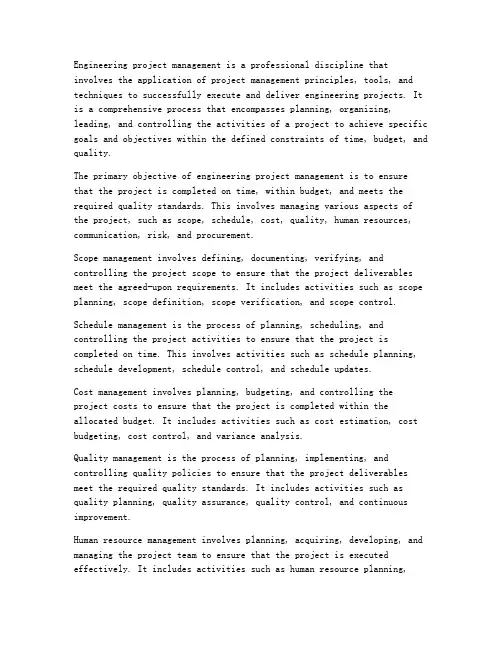
Engineering project management is a professional discipline that involves the application of project management principles, tools, and techniques to successfully execute and deliver engineering projects. It is a comprehensive process that encompasses planning, organizing, leading, and controlling the activities of a project to achieve specific goals and objectives within the defined constraints of time, budget, and quality.The primary objective of engineering project management is to ensurethat the project is completed on time, within budget, and meets the required quality standards. This involves managing various aspects of the project, such as scope, schedule, cost, quality, human resources, communication, risk, and procurement.Scope management involves defining, documenting, verifying, and controlling the project scope to ensure that the project deliverables meet the agreed-upon requirements. It includes activities such as scope planning, scope definition, scope verification, and scope control.Schedule management is the process of planning, scheduling, and controlling the project activities to ensure that the project is completed on time. This involves activities such as schedule planning, schedule development, schedule control, and schedule updates.Cost management involves planning, budgeting, and controlling theproject costs to ensure that the project is completed within the allocated budget. It includes activities such as cost estimation, cost budgeting, cost control, and variance analysis.Quality management is the process of planning, implementing, and controlling quality policies to ensure that the project deliverables meet the required quality standards. It includes activities such as quality planning, quality assurance, quality control, and continuous improvement.Human resource management involves planning, acquiring, developing, and managing the project team to ensure that the project is executed effectively. It includes activities such as human resource planning,staffing, training and development, performance management, and conflict resolution.Communication management involves planning, implementing, andcontrolling the project communication to ensure that the relevant information is effectively communicated to the stakeholders. It includes activities such as communication planning, communication tools and techniques, and stakeholder management.Risk management involves identifying, analyzing, and responding to risks that may impact the project objectives. It includes activities such as risk identification, risk analysis, risk response planning, and risk monitoring and control.Procurement management involves obtaining goods and services from external sources to meet the project requirements. It includesactivities such as procurement planning, solicitation, supplier selection, contract administration, and contract closure.Engineering project management also involves several key processes, such as project initiation, project planning, project execution, project monitoring and controlling, and project closing. Each of these processes has specific objectives, activities, and outputs that contribute to the successful completion of the project.Project initiation involves identifying and defining the project, as well as obtaining approval for the project. It includes activities such as project charter development, feasibility study, and business case preparation.Project planning involves developing the project management plan, which includes the project scope statement, schedule, budget, quality management plan, human resource plan, communication plan, risk management plan, and procurement plan.Project execution involves implementing the project management plan to execute the project activities and deliver the project outputs. It includes activities such as resource allocation, task execution, and project coordination.Project monitoring and controlling involves tracking, reviewing, and managing the project performance to ensure that the project objectives are achieved. It includes activities such as progress reporting, performance measurement, variance analysis, and corrective actions.Project closing involves completing all project activities, documenting lessons learned, and transitioning the project deliverables to the stakeholders. It includes activities such as project closure documentation, project review, and project handover.In conclusion, engineering project management is a complex and dynamic process that requires a comprehensive understanding of project management principles and techniques. Effective engineering project management can lead to the successful completion of projects, ensuring that the desired outcomes are achieved within the defined constraints.。
项目管理专用中英文术语词汇
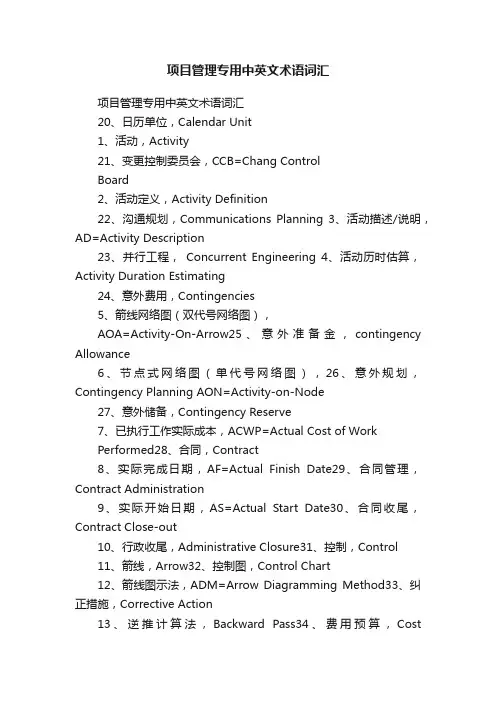
项目管理专用中英文术语词汇项目管理专用中英文术语词汇20、日历单位,Calendar Unit1、活动,Activity21、变更控制委员会,CCB=Chang ControlBoard2、活动定义,Activity Definition22、沟通规划,Communications Planning 3、活动描述/说明,AD=Activity Description23、并行工程,Concurrent Engineering 4、活动历时估算,Activity Duration Estimating24、意外费用,Contingencies5、箭线网络图(双代号网络图),AOA=Activity-On-Arrow25、意外准备金,contingency Allowance6、节点式网络图(单代号网络图),26、意外规划,Contingency Planning AON=Activity-on-Node27、意外储备,Contingency Reserve7、已执行工作实际成本,ACWP=Actual Cost of WorkPerformed28、合同,Contract8、实际完成日期,AF=Actual Finish Date29、合同管理,Contract Administration9、实际开始日期,AS=Actual Start Date30、合同收尾,Contract Close-out10、行政收尾,Administrative Closure31、控制,Control11、箭线,Arrow32、控制图,Control Chart12、箭线图示法,ADM=Arrow Diagramming Method33、纠正措施,Corrective Action13、逆推计算法,Backward Pass34、费用预算,CostBudgeting14、横道图,Bar Chart35、费用控制,Cost Control15、基准计划,Baseline36、费用做算,Cost Estimating16、完工预算,BAC=Budget At Completion37、质量成本,Cost of Quality17、概算,Budget Estimate38、费用绩效指数,CPI=Cost Performance Index18、已执行预算成本,BCWP=Budgeted Cost of Work39、费用偏差,CV=Cost VariancePerformed40、赶工,Crashing19、计划执行预算成本,BCWS= Budgeted Cost ofScheduled41、关键工序,Critical Activity42、关键路线,Critical Path64、完成到开始关系,FS=Finish-to-Start43、关键路线法,CPM=Critical Path Method65、时差,机动时间,浮动时间,Float44、当前完成日期,Current Finish Date66、顺推计算法,Forward Pass45、当前开始日期,Current Start Date67、自由时差,FF=Free Float46、数据日期,DD=Data Date68、职能经理,Functional Manager47、交付物,Deliverable69、职能组织,Functional Organization48、依赖关系,Dependency70、甘特图,Gantt Chart49、虚活动,Dummy Activity71、图解评审技术,GERT=Graphical Evaluation and 50、延续时间,DU=Duration Review Technique51、延续时间压缩,Duration Compression72、集合工作,Hammock52、最早完工日期,EF=Early Finish Date73、悬摆,Hanger53、最早开始日期,ES=Early Start Date74、信息分发,Information Distribution54、挣值法,EV=Earned Value75、立项,Initiation55、挣值分析,Earned Value Analysis76、成本/进度综合报告,IntegratedCost/ScheduleReporting56、人工量,Effort77、邀标,IFB= Invitation for Bid57、估算,概算,Estimate78、关键事件进度计划,Key Event Schedule 58、在完成时的费用估算,EAC=Estimate AtCompletion79、滞后量,Lag59、到完成时的估算,ETC=Estimate To Complete80、最晚完成日期,LF=Late Finish Date60、单节点事件图,Event-on-Node81、最晚开始日期,LS=Late Start Date。
工程项目管理英文单词
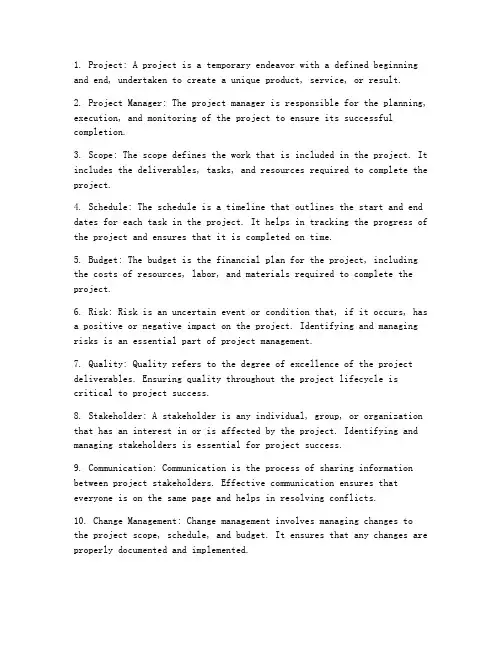
1. Project: A project is a temporary endeavor with a defined beginning and end, undertaken to create a unique product, service, or result.2. Project Manager: The project manager is responsible for the planning, execution, and monitoring of the project to ensure its successful completion.3. Scope: The scope defines the work that is included in the project. It includes the deliverables, tasks, and resources required to complete the project.4. Schedule: The schedule is a timeline that outlines the start and end dates for each task in the project. It helps in tracking the progress of the project and ensures that it is completed on time.5. Budget: The budget is the financial plan for the project, including the costs of resources, labor, and materials required to complete the project.6. Risk: Risk is an uncertain event or condition that, if it occurs, hasa positive or negative impact on the project. Identifying and managing risks is an essential part of project management.7. Quality: Quality refers to the degree of excellence of the project deliverables. Ensuring quality throughout the project lifecycle is critical to project success.8. Stakeholder: A stakeholder is any individual, group, or organization that has an interest in or is affected by the project. Identifying and managing stakeholders is essential for project success.9. Communication: Communication is the process of sharing information between project stakeholders. Effective communication ensures that everyone is on the same page and helps in resolving conflicts.10. Change Management: Change management involves managing changes to the project scope, schedule, and budget. It ensures that any changes are properly documented and implemented.11. Quality Assurance: Quality assurance is the process of ensuring that the project deliverables meet the specified requirements and standards.12. Quality Control: Quality control is the process of monitoring and controlling the project deliverables to ensure that they meet the required quality standards.13. Project Life Cycle: The project life cycle is the sequence of phases that a project goes through from initiation to closure. It includes the following phases:a. Initiation: Defining the project scope, objectives, and stakeholders.b. Planning: Developing a detailed plan for the project, including the schedule, budget, and resources.c. Execution: Implementing the project plan and managing the project activities.d. Monitoring and Controlling: Tracking the project progress and ensuring that it is on schedule and within budget.e. Closing: Completing the project, documenting lessons learned, and celebrating the success.14. Critical Path Method (CPM): CPM is a project management technique used to determine the sequence of activities and the time required to complete a project.15. Program Management: Program management involves managing multiple related projects to achieve strategic business objectives.In conclusion, engineering project management is a dynamic and complex field that requires a comprehensive understanding of various concepts, techniques, and tools. The terms and words mentioned above are just a few examples of the many terms used in engineering project management. By familiarizing yourself with these terms, you will be better equipped to manage projects effectively and efficiently.。
项目管理术语中英文对照
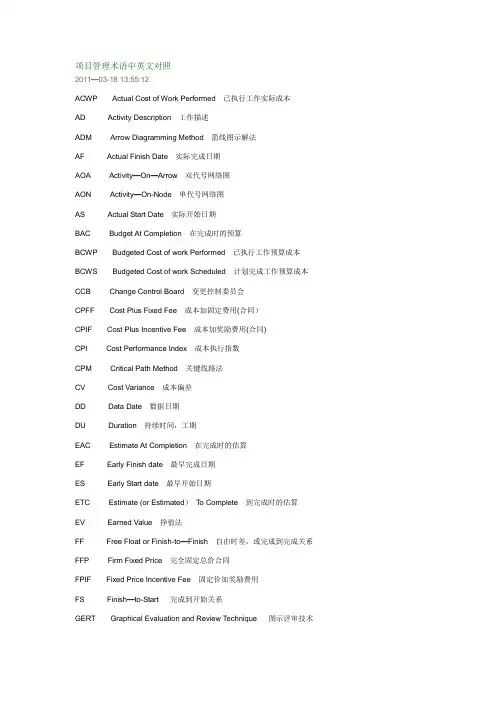
项目管理术语中英文对照2011—03-18 13:55:12ACWP Actual Cost of Work Performed 已执行工作实际成本AD Activity Description 工作描述ADM Arrow Diagramming Method 箭线图示解法AF Actual Finish Date 实际完成日期AOA Activity—On—Arrow 双代号网络图AON Activity—On-Node 单代号网络图AS Actual Start Date 实际开始日期BAC Budget At Completion 在完成时的预算BCWP Budgeted Cost of work Performed 已执行工作预算成本BCWS Budgeted Cost of work Scheduled 计划完成工作预算成本CCB Change Control Board 变更控制委员会CPFF Cost Plus Fixed Fee 成本加固定费用(合同)CPIF Cost Plus Incentive Fee 成本加奖励费用(合同)CPI Cost Performance Index 成本执行指数CPM Critical Path Method 关键线路法CV Cost Variance 成本偏差DD Data Date 数据日期DU Duration 持续时间,工期EAC Estimate At Completion 在完成时的估算EF Early Finish date 最早完成日期ES Early Start date 最早开始日期ETC Estimate (or Estimated)To Complete 到完成时的估算EV Earned Value 挣值法FF Free Float or Finish-to—Finish 自由时差,或完成到完成关系FFP Firm Fixed Price 完全固定总价合同FPIF Fixed Price Incentive Fee 固定价加奖励费用FS Finish—to-Start 完成到开始关系GERT Graphical Evaluation and Review Technique 图示评审技术IFB Invitation For Bid 邀标LF Late Finish Date 最晚完成日期LOE Level of Effort 投入水平LS Late Start date 最晚开始日期MPM Modern Project Management 现代项目管理OBS Organization(al)Breakdown Structure 组织分解结构PC Percent Complete 完成百分比PDM Precedence Diagramming Method 优先图示法PERT Program Evaluation and Review Technique 计划评审技术PF Planned Finish date 计划完成日期PM Project Management or Project Manager 项目管理或项目经理PMBOK Project Management Body of Knowledge 项目管理知识体系PMP Project Management Professional 项目管理专业人员PS Planned Start date 计划开始日期QA Quality Assurance 质量保障QC Quality Control 质量控制RAM Responsibility Assignment Matrix 责任分配矩阵RDU Remaining DUration 剩余工期RFP Request For Proposal 请求建议书RFQ Request For Quotation 请求报价单SF Scheduled Finish date or Start-to-Finish 计划完成日期或开始到完成关系SOW Statement of Work 工作说明SPI Schedule Performance Index 进度执行指数SS Scheduled Start date or Start-to-Start 计划开始日期或开始到开始关系SV Schedule Variance 进度偏差TC Target Completion date 目标完成日期TF Total Float or Target Finish date 总时差,或目标完成日期TS Target Start date 目标开始日期TQM Total Quality Management 全面质量管理WBS Work Breakdown Structure 工作分解结构定义这里定义的许多词,在词典的定义中具有更广泛的意义,在某些情况下具有不同的意义。
工程项目管理英语
Introduction:Engineering project management is a critical field that involves the application of project management principles and techniques to the planning, execution, and completion of engineering projects. It requires a strong command of both technical and management skills. In this article, we will explore some essential terms and phrases related to engineering project management in English.1. Project Initiation:- Define the project scope: "We need to define the scope of the project before we start."- Establish project objectives: "Let's set specific and measurable goals for each stage of the project."- Identify stakeholders: "We should create a project plan that outlines the tasks, timelines, and resources needed."2. Project Planning:- Develop a project plan: "We should create a project plan that outlines the tasks, timelines, and resources needed."- Identify project activities: "We need to identify the key activities and sequence them logically."- Allocate resources: "We should allocate resources effectively to ensure project success."- Estimate project duration: "We need to estimate the project duration based on the available resources."3. Project Execution:- Monitor project progress: "We need to monitor the progress of the project regularly and make adjustments as needed."- Manage project risks: "We should identify and manage project risks proactively."- Coordinate team members: "It's important to assign responsibilities and roles to each team member."- Communicate with stakeholders: "We should communicate regularly with stakeholders to keep them informed of the project's progress."4. Project Control:- Perform project status reports: "We should prepare project status reports to track the project's progress."- Analyze project performance: "We need to analyze project performance to identify any deviations from the plan."- Implement corrective actions: "We should implement corrective actions to address any issues or delays."- Control project costs: "We need to control project costs by managing resources effectively."5. Project Closure:- Conduct project review: "We should conduct a project review to evaluate the project's success and identify lessons learned."- Document project deliverables: "We need to document all project deliverables to ensure a smooth handover to the client."- Celebrate project success: "Let's celebrate the successful completion of the project."6. Common Engineering Project Management Terms:- Scope creep: "Scope creep refers to the uncontrolled expansion of a project's scope."- Critical path method (CPM): "CPM is a project management technique used to identify the critical activities in a project."- Risk management: "Risk management involves identifying, analyzing, and mitigating risks in a project."- Quality control: "Quality control ensures that the projectdeliverables meet the required standards."- Resource allocation: "Resource allocation involves assigning resources to project activities effectively."Conclusion:Engineering project management is a complex and challenging field that requires effective communication, collaboration, and technical expertise. By mastering the essential terms and phrases in English, professionals can enhance their ability to manage projects successfully andefficiently. Whether you are a project manager, engineer, or stakeholder, being proficient in engineering project management terminology can help you navigate the complexities of the industry and achieve project success.。
工程项目管理专业英语
Engineering projects are complex endeavors that require meticulous planning, execution, and control to ensure successful completion. As the world becomes increasingly globalized, the need for professionals whocan effectively communicate and manage engineering projects in Englishis paramount. This article aims to provide an overview of key terms, concepts, and practices in engineering project management, translatedinto professional English, to help professionals navigate this fieldwith confidence.Key Terms and Definitions:1. Project Management (PM): The application of knowledge, skills, tools, and techniques to project activities to meet the project requirements.It involves the integration of all project elements to achieve theproject objectives within the agreed constraints.2. Project Manager (PM): The individual responsible for leading the project team and ensuring the successful completion of the projectwithin the defined scope, schedule, and budget.3. Project Scope: The defined and documented deliverables of the project, including the work to be performed and the results to be achieved.4. Project Schedule: A document that defines the project's timeline, including start and end dates for activities, milestones, and thecritical path.5. Project Budget: The financial resources allocated to the project, including costs for labor, materials, equipment, and other expenses.Key Concepts and Practices:1. Project Planning: The process of defining the project's objectives, scope, and deliverables, and developing a detailed plan to achieve them. This includes identifying project stakeholders, defining project tasks, estimating resources, and establishing a project schedule.2. Risk Management: The process of identifying, analyzing, and responding to risks that may affect the project. This involvesidentifying potential risks, assessing their impact and likelihood, and developing strategies to mitigate or avoid them.3. Quality Management: The process of ensuring that the project deliverables meet the required quality standards. This includes establishing quality policies, planning quality activities, and implementing quality control measures.4. Change Management: The process of managing changes to the project scope, schedule, or budget. This involves assessing the impact of changes, obtaining approval for changes, and updating project documentation accordingly.5. Configuration Management (CM): The process of identifying, organizing, and controlling modifications made to the project deliverables. CM ensures that the project's configuration items are properly documented, tracked, and managed throughout the project lifecycle.Practical Examples:1. Project Change Request (PCR): A formal document submitted by aproject stakeholder requesting a change to the project scope, schedule, or budget. The project manager must assess the impact of the change and obtain approval from relevant stakeholders before implementing it.2. Feasibility Analysis: A study conducted to determine whether aproject is technically, economically, and operationally feasible. This analysis helps project managers make informed decisions about whether to proceed with the project.3. Project Management Office (PMO): A centralized office within an organization responsible for overseeing the management of projects. The PMO provides support to project managers and ensures that projects are aligned with the organization's strategic objectives.In conclusion, engineering project management is a dynamic and challenging field that requires a strong command of professional English. By understanding key terms, concepts, and practices, professionals caneffectively communicate and manage engineering projects, contributing to their success and the success of their organizations.。
工程管理专业英语相关翻译
1.1T he Project Life Cycle1段:Project managers or the organization can divide projects into phases to provide better management control with appropriate links to the ongoing operations of the performing organization. Collectively, these phases are known as the project life cycle. Many organizations identify a specific set of life cycles for use on all of their projects.项目经理或组织可以把每一个项目划分成若干个阶段,以便有效地进行管理控制,并与实施该项目组织的日常运作联系起来。
这些项目阶段合在一起称为项目生命期。
许多组织识别出一套具体的生命期供其所有的项目使用。
2段:For example, from the perspective of an owner, the project life cycle for a constructed facility may be illustrated schematically in Figure1-1.从业主的角度来看,建设项目的生命周期可用图1-1表示。
Essentially, a project is conceived to meet market demands or needs in a timely fashion.从本质上讲,一个项目试图及时满足市场需求。
in a timely fashion. 及时meet market demands or needs 满足市场需求Various possibilities may be considered in the conceptual planning stage, and the technological and economic feasibility of each alternative will be assessed and compared in order to select the best possible project.在项目规划阶段,很多不同的方案都可能被考虑,同事每一天备选方案的技术可行性都经过评估和比较,以选出最优方案。
工程项目管理常用英汉词汇
工程项目管理常用英汉词汇An English-Chinese Glossary of Terms Commonly Used in Engineering Project Management工程项目管理常用英汉词汇1Aabsolute guarantees 绝对保证activity 工序;活动actual cost for work performed [ACWP]已完工作量的实耗费用adjusted man-hours 修正的人工事估算值advance payment;down payment 预付款advance payment bond;bank guarantee for advance payment 预付款保函;为预付款出具的银行保证书advanced certified final drawings [ACF];advanced certified vendors'drawings;preliminary vendor drawings [PD]供货厂商先期确认图(纸)ahead of schedule 进度提前analysis estimate 分析估算analytical engineering phase 分析设计阶段anticipated approved cost 认可的预计费用approved client change 认可的用户变更architectural engineering 建筑at completion variance [ACV]竣工差异Bbank guarantee;letter of guarantee [L/G]银行保证书;信用保证书bar;bar-chart;Gantt chart 横道图basic engineering phase 基础工程设计阶段battery limit [BL]界区bid;quotation;proposal;tender;offer 报价;投标bid bond 投标保函bid evaluation 标书评审;报价评审bid strategy meeting 报价策略会议bid tabulation form;tabulation of bids 标书评选表;报价评选表bill for negotiation 议付汇票bill of entry 报关单bill of exchange;draft 汇票bill of lading 提单bill of materials [BOM]材料表;材料清单bond 保函;担保(书)bonded goods 保税货物bonded warehouse 保税仓库breakdown structure 分解结构budget;project control budget 预算(值);项目控制预算budget change procedure 预算变更程序budgeted cost at completion [BAC]竣工预算费用budgeted cost for work performed [BCWP]已完工作量的预算费用budgeted cost for work scheduled [BCWS]计划工作量的预算费用bulk materials;commodities 散装材料bulk materials cost;purchased cost of bulk materials;commodities cost 散装材料费用;散装材料购买费用buyer's credit [B/C]买方信贷Ccertificate 证书;证明书certificate of origin 产地证明书工程项目管理常用英汉词汇2certified final drawings [CF];certified vendor drawings[CD]供货厂商最终确认图(纸)change 变更change control procedure 变更控制程序change request;deviation notice [DN]变更申请单;偏差通知单check estimate 核定估算chemical cleaning procedure 化学清洗程序civil engineering 土建claim;claim indemnity 索赔client 用户;客户client acceptance 用户验收client acceptance certificate (of plant)用户验收证书;合同项目验收证书client change;contract change 用户变更;合同变更client change notice [CCB];contract change order [CCO]用户变更(通知)单;合同变更(通知)单client kick-off meeting 用户开工会议close-out report (项目)完工报告code;number 代码;编码commissioning 试车commissioning activities cost 试车费用commitment 订货合约;定约;成交confirmed L/C 保兑信用证construction 施工construction cost 施工费用construction craft 施工工种construction mobilization meeting 施工动员会议construction phase 施工阶段contingency 不可预见费contract 合同;承包contract award 签订合同;合同签约contractor 承包商contractor's standard work breakdown structure [CSWBS]承包商标准工作分解结构;工程公司标准工作分解结构control baseline;performance measurement baseline;progress baseline 控制基准;执行效果测量基准;实物进度基准control estimate 控制估算control index 控制索引corrective action;corrective measures 纠正措施cost 费用;成本cost and freight [CFR]or [C&F]成本加运费(价)cost control 费用控制;成本控制cost index [CI]费用指数cost insurance and freight;cost insurance freight [CIF]到岸价cost of construction indirect 施工间接费用cost of construction supervision;cost of construction management and supervision;field administration and direct supervision cost [FADS]施工监督费用;施工监督和管理费用cost of material related freight;insurance,etc.(直接)材料相关费用(运费和保险费等)cost performance index [CPI]费用执行效果指数cost plus fixed fee contract [CPFF]成本加固定酬金合同cost plus fluctuating fee contract;cost plus sliding scale fee contract 成本加浮动酬金合同cost trend display chart 费用趋势展示图工程项目管理常用英汉词汇3cost variance [CV]费用差异(cost)reimbursable contract;cost-plus (fee)contract [C-P]偿付合同;成本加抽筋合同CREDIT 信贷critical activity 关键工序;关键活动critical path method [CPM]关键线路法Ddata 数据default 违约default notice 违约通知defined equipment estimate;definitive estimate 设备详细估算(发);确切估算(发)delivery 交货delivery date;date of delivery 交货日期delivery note 交货单delivery order 提货单delivery terms 交货条件delivery to job-site 交货到现场demand loan 即期贷款design;engineering 设计;工程设计detailed engineering phase;final engineering phase;production engineering phase 详细工程设计阶段detailed estimate;defined estimate 详细估算(发)detailed network 详细网络图detailed schedule 详细进度计划;详细进度表deviation;variance 偏差;差异diagram;chart 图表discipline 专业drawing 图纸drawing issued "Approved for Design"[AFD]“批准用于详细工程设计”图纸drawing on L/Cs 信用证提款drawings issued "Approved for construction"[AFC]“批准用于施工”图纸duties 关税Eearned value concept [EVC]赢得值原理effective date of the contract 合同生效日期electrical engineering 电气engineering monthly progress report 设计进展月报engineering phase 设计阶段equipment 设备equipment cost;purchased cost of equipment 设备费用;设备购买费用equipment engineering 设备equipment estimate 设备估算estimate;cost estimate 估算;费用估算estimated cost at completion [EAC]竣工预测费用ex works [EXW]工厂交货(价)exception report 异常报告expediting 催交Ffinal payment 最终付款first check estimate [FCE]首次核定估算工程项目管理常用英汉词汇4(fixed)unit price contract (固定)单价合同"float"浮动时间;工序时差forwarding agent 运输商;承运商free alongside ship [FAS]船边交货(价)free carrier [FCA]货交承运人(价)free on board [FOB]离岸价free on rail [FOR];free on truck [FOT]铁路交货(价);敞车上交货(价)freight [Frt.];carriage 运费freight collect;freight to be collected;freight payable at destination 运费待收;货到收运费freight forward;carriage forward 货到付运费;运费未付freight indemnity 运费担保函freight note 运费单freight paid;carriage free;carriage paid 运费付讫freight prepaid;advance(d)freight 运费预付frustration of contract 合同失效Ggeneric activity type (numbers)[GAT]通用型活动码group code 组码guarantee;warranty 保证;担保Hhistogram 直方图home office 公司本部home office cost;cost of home office servers 公司本部(服务)费用home office service 公司本部服务Iincome taxes 所得税initial approved cost [IAC]批准的控制估算initial phase of project execution 项目初始阶段initial process release 工艺预发表inquiry;invitation to bid 询价;招标inquiry review committee [IRC]讯价文件评审委员会inquiry(package);request for quotation(package)[RFQ];request for proposal [RFP];invitation to bid [ITB]询价书;招标文件inspection 检验inspection report 检验报告instructions to bidders [ITB]投标者须知;报价须知instruments engineering 仪表insurance;assurance 保险insurance certificate 保险证书insurance policy 保险单insurance premium 保险费integrated project control 项目综合控制interim control estimate;initial control estimate [ICE]初期控制估算internal transfer 内部费用转换irrevocable L/C 不可撤销信用证isometric drawing 管段图;管道空视图issue;release 发表J(job)monthly progress report (项目)进展月报joint venture [JV]合营企业工程项目管理常用英汉词汇5Kkick-off meeting 开工会议know-how 专有技术;技术诀窍know-how fee 专有技术费Llabor cost;erection labor cost;construction force cost 施工人工费用;施工劳力费用labor cost associated with bulk materials 散装材料施工人工费用labor cost associated with equipment 设备安装人工费用labor productivity;productivity factor;productivity ratio 劳动生产率;劳动生产率系数lead time 交货周期letter of comfort 安慰信letter of credit [L/C]信用证letter of intent 意向书license 许可证license fee 许可证费licensed technology 专利技术licensee 受许可放;受让方licensor 专利商;许可方line item 任务单项line of credit 信贷额度liquidated damages 违约罚金loan 贷款lump-sum contract[L-S]总价合同Mman-hour estimate 人工时估算man-hour rate 人工时单价material 材料material class 材料分类material control 材料控制material cost;direct material cost 材料费用;直接材料费用material exception report [MER];equipment &materials exception report 材料异常报告material management 材料管理material status report 材料状态报告material take-off [MTO]材料统计mechanical completion [MC]机械竣工mechanical completion certificate 机械竣工证书mechanical guarantees;mechanical warranties 机械保证;机械担保meeting 会议milestone 里程碑milestone network 里程碑网络图monitoring 监控monthly cost and progress report 费用和进展月报告Nnegotiation 谈判network (diagram)网络(图);网络(进度)计划non-payroll;home-office expenses 非工资费用Ooffsite battery limit [OSBL]界外设施区;辅助设施界区offsite section;offsite unit;offsite facilities;general facilities 界外设施;辅助设施;通用设施organizational breakdown structure [OBS]组织分解机构工程项目管理常用英汉词汇6other costs 其他费用overhead;home office overheads 公司管理费over-run;cost over-run 预算超支(值);费用超支(值)owner 业主Ppatent 专利patent right 专利权penaltiable guarantees 违约罚款保证penalty clause (违约)罚款条款pending client change 待定的用户变更performance 执行效果;效绩;性能performance bond;performance bank guarantee 履约保函;履约担保(书);为履约出具的银行保证书performance guarantees 性能保证performance report 执行效果报告performance test run;performance guarantee tests 性能考核,生产考核performance test run procedure;performance guarantee test procedure 性能考核程序;生产考核程序piping and instrument diagram [PID][P&ID]管道仪表流程图piping design 管道设计piping layout drawing 管道平面布置图piping mechanical engineering 管道机械piping planning (drawing)管道平面设计图plan 计划planning engineering phase 平面设计阶段plant acceptance procedure 装置验收程序plant layout engineering 布置plot plan 装置布置图precommissioning 试车准备pre-qualification 资格预审procedure 程序process battery limit;inside battery limit [ISBL]工艺界区process control diagram [PCD]工艺控制图process design 工艺设计process design;process engineering 工艺process design phase 工艺设计阶段process flow diagram [PFD]工艺流程图process package 工艺包process release 工艺发表process section;process unit 工艺装置procurement 采购procurement status report 采购状态报告production check estimate [PCE]二次核定估算productivity report 劳动生产率报告profit;expected profit 利润;预期利润progress;physical progress 进展;进度;实物进度progress curve;"S"curve 进度曲线;S 曲线progress payment 按实物进度付款project 项目;工程项目工程项目管理常用英汉词汇7project change;internal change 项目变更;内部变更project change notice [PCN];internal change order [ICO]项目变更(通知)单;内部变更(通知)单project commissioning procedure;project start-up procedure;project test run procedure 项目试车程序;项目开车程序project construction manager [PCM]项目施工经理(project)construction plan (项目)施工计划project control 项目控制project control procedure 项目控制程序project controlling;tools for project control 项目控制手段project controls manager 项目控制经理project coordination procedure 项目协调程序project cost control engineer;project cost engineer 项目费用控制工程师project cost summary report 项目费用汇总报告project duration's 项目建设周期project engineering manager [PEM]项目设计经理(project)engineering plan (项目)设计计划project engineering procedure 项目设计程序project estimator 项目估算师project execution 项目实施费用状态报告project execution procedure 项目实施程序project finance 项目融资;工程项目筹资project financial manager 项目财务经理project inspection procedure 项目检验程序project kick-off meeting 设计开工会议project kick-off meeting 项目开工会议project management 项目管理project manager [PM]项目经理project master schedule;master project schedule 项目主进度计划project material control engineer 项目材料控制工程师project operation cost status report 项目实施费用状态报告project phase 项目实施阶段project plan 项目计划project process manager 项目工艺经理project procurement manager [PPM]项目采购经理(project)procurement plan (项目)采购计划project procurement procedure 项目采购程序project quality manager 项目质量经理project safety engineer 项目安全工程师project scheduling engineer;project scheduler 项目进度计划工程师project secretary 项目秘书project start-up manager 项目开车经理(project)start-up plan (项目)开车计划工程项目管理常用英汉词汇8project summary work breakdown structure[PSWBS]项目大项工作分解结构project team 项目组projected deviations 偏差预测值projection;forecasting 预测proposal;quotation;bid;tender;offer 投标书;标书;建议书proposal estimate 报价估算proposal kick-off meeting 报价开工会议proposal manager 报价经理proprietary technology 产权技术purchase order [PO]订单(即定单);采买订单;订货合同purchase order and requisition status report 请购单和订单状态报告purchasing 采买purchasing specification [PS]采购规格书;采购说明书Qqualified bidders list;qualified vendors list 合格投标商表;合格供货商表quality 质量quality assurance [QA]质量保证quality control [QC]质量控制quality improvement 质量改进quality management 质量管理quality manual 质量手册quality plan 质量计划quality planning 质量策划quality policy 质量方针quality system 质量体系Rreimbursable guaranteed maximum price contract [RGMP];guarantee maximum cost plus fee contract 限定最高价偿付合同;限定最高成本加抽筋合同report 报告requisition (package);requisition documents 请购文件;请购单resource loading curve;Bell curve 资源负荷曲线responsibility assignment matrix [RAM]责任分工矩阵resultant feedback of data 返回的条件数据;返回的设计条件retention money 保留金;扣留款review meeting 审核会revocable L/C 可撤销信用证risk 风险risk analysis 风险分析risk memorandum 风险备忘录royalty (技术)转让费;提成费Sschedule 进度;进度表;进度计划schedule control;progress control 进度控制schedule delay 进度拖延schedule index [SI]进度指数schedule payment 按日工程进度付款schedule performance index [SPI]进度执行效果指数schedule report 进度报告schedule trend display chart 进度趋势展示图schedule variance [SV]进度差异工程项目管理常用英汉词汇9scheduling;time scheduling 编制进度计划scope of work;project scope 工作范围;项目任务范围secrecy agreement 保密协议service gains 服务酬金sight credit;sight L/C 即期信用证standard classification of account numbers [SCAN];account codes;code of accounts 标准分类记帐码;记帐码standard man-hours;standard labor man-hours;standard construction man-hours;standard hours 人工时估算定额;施工人工时估算定额;标准工时定额stand-by L/C 备用信用证starter schedule;early work schedule (项目)初期工作进度计划start-up 开车start-up;test run;initial operations 投料试车start-up cost 投料试车费用start-up phase 开车阶段subcontract cost;field subcontract cost 分包合同费用;现场施工分包合同费用subcontractor 分包商SUPPLIER'S CREDIT [S/C]卖方信贷supporting data 条件数据;设计条件surety bond 保证书;保险公司出具的保函systems engineering 系统T(target)cost plus fee contract,with bonus or penalty conditions 目标成本加奖罚合同task force 专责项目组tax avoidance 合法避税tax(es)税;税金telex order;notification of commitment 订货电传;订货通知term credit;term L/C 远期信用证termination of contract 合同终止terms of payment;conditions of payment;terms and conditions of payment 支付条件;付款条件total installed cost [TIC]建设总费用tracking;follow up 跟踪traffic;transport 运输training 培训transferable L/C 可转让信用证trending;trend projection 趋势分析;趋势预测types of estimate 估算方法类别Uunder-run;cost under-run 预算结余(值);费用结余(值)utility 公用工程Vvariable code;optional variable code 可编码vendor coordination meeting [VCM];coordination meeting 厂商协调会议;协调会议工程项目管理常用英汉词汇vendor drawing status report;vendordata scheduling status report供货厂商图纸状态报告Wwork breakdown structure[WBS]工作分解结构work item工作项work package工作包workmanship guarantees工作质量保证10。
- 1、下载文档前请自行甄别文档内容的完整性,平台不提供额外的编辑、内容补充、找答案等附加服务。
- 2、"仅部分预览"的文档,不可在线预览部分如存在完整性等问题,可反馈申请退款(可完整预览的文档不适用该条件!)。
- 3、如文档侵犯您的权益,请联系客服反馈,我们会尽快为您处理(人工客服工作时间:9:00-18:30)。
81、The construction contract price includes the direct project cost including field supervisionexpenses plus the markup imposed by contractors for general overhead expenses and profit.建设工程合同价格由包括现场管理费在内的直接工程费和承包商添加的包括间接费和利润在内的增加值这两部分组成。
2、Within each of the major categories of construction such as residential housing, commercial buildings, industrial complexes and infrastructure, there are smaller segments which have very different environments with regard to price setting.在建设工程的每一主要类型中(如居住用房、商业建筑、工业建筑和基础建设),有更小的部分,关于价格的制定有非常不同的环境。
3、However, all pricing arrangements have some common features in the form of the legaldocuments binding the owner and the supplier(s) of the facility.约束业主和设备供应商的法律文件形式规定的计价方式是有一些相同之处的。
4、Without addressing special issues in various industry segments, the most common types ofpricing arrangements can be described broadly to illustrate the basic principles.在不考虑各建筑类型不同的情况下,最常用的计价方式可以根据概括介绍如下,并说明其基本原则。
5、The basic structure of the bidding process consists of the formulation of detailed plans andspecifications of a facility based on the objectives and requirements of the owner, and the invitation of qualified contractors to bid for the right to execute the project.招投标过程中的基本结构由根据业主的目标和要求编制实施的详细图纸和技术要求说明书,以及邀请合格的承包商为取得工程施工的权利而投标所组成的。
6、In the private sector, the owner has considerable latitude in selecting the bidders, rangingfrom open competition to the restriction of bidders to a few favored contractors.在私营部门,业主在选择投标人有相当大的自由,范围从公开竞争的投标人到将投标人限制在若干个业主所喜欢的投标人。
7、In the public sector, the rules are carefully delineated to place all qualified contractors on anequal footing for competition, and strictly enforced to prevent collusion among contractors and unethical or illegal actions by public officials.在公共项目领域中,需详细的制定规则,以使所有预审合格的承包商在平等基础上竞争,并严格执行,以防止承包商之间的相互串通和政府官员的不道德或违法行为。
8、In such cases, the contractor is permitted to submit a list of unit prices for those tasks, andthe final price used to determine the lowest bidder is based on the lump sum price computed by multiplying the quoted unit price for each specified task by the corresponding quantity in the owner's estimates for quantities.在这种情况下,允许承包商提交这些任务的分部分项工程量的单价表,而于确定最低投标人的最终价格是基于总投标报价时所用的计算方法,既通过将通过承包商对每一具体分部分项工程所报的单价乘以业主估算的相应工程量。
9、A major reason for using negotiated contracts is the flexibility of this type of pricingarrangement, particularly for projects of large size and great complexity or for projects which substantially duplicate previous facilities sponsored by the owner采用协议合同的一个主要原因在于这种计价方式的灵活性,尤其是规模较大的和复杂程度高的工程,或者是十分类似业主以前发起的工程。
10、Because the basic needs of home buyers are very similar and home designs can bestandardized to some degree, the probability of finding buyers of good housing units withina relatively short time is quite high.因为购房者的基本需求是都非常类似,因此住房的设计可以在一定程度上标准化,所以好的房子在短时间内找到购买者的可能性非常高。
101、Good scheduling can eliminate problems due to production bottlenecks, facilitate the timelyprocurement of necessary materials, and otherwise insure the completion of a project as soon as possible.一个好的计划可以消除生产瓶颈所带来的问题,便于必备材料的及时采购,同时可尽可能地保证工程如期的完成。
2、In contrast, poor scheduling can result in considerable waste as laborers and equipment waitfor the availability of needed resources or the completion of preceding tasks.相反,不合理的计划则会导致因等待所需资源的可用和前任务的完成所造成的人工和设备的大量浪费。
3、After the completion of construction, similar comparisons between the planned scheduleand the actual accomplishments may be performed to allocate the liability for project delays due to changes requested by the owner, worker strikes or other unforeseen circumstances.在工程完工之后,通过类似于计划进度和实际进度之间的比较,可以对由于业主提出的变更要求、工人罢工或者其他不可预见的情况导致的工程延期的责任进行分摊。
4、In particular, the critical path method of scheduling is commonly required by owners and hasbeen taught in universities for over two decades, but is often regarded in the field as irrelevant to actual operations and a time consuming distraction.尤其是业主普遍需要的进度计划中的关键线路发法,这种方法虽然在大学里已经教授了二十几年了,但是在一些领域中,这种方法经常不但被认为与一些实际操作毫无相关,而且是对时间和精力的浪费。
5、The result is "seat-of-the-pants" scheduling that can be good or that can result in grosslyinefficient schedules and poor productivity.结果无论是好的还是导致低效率和低生产率的那些进度计划只能做冷板凳6、As a result, the continued development of easy to use computer programs and improvedmethods of presenting schedules have overcome the practical problems associated with formal scheduling mechanisms.事实上,易于上手的计算机软件的不断发展和现有计划方法的改进,已经解决了与正规计划手段有关的实际问题。
7、For example, the project manager's main concern on a high-rise building site might be toinsure that cranes are used effectively for moving materials; without effective scheduling in this case, delivery trucks might queue on the ground and workers wait for deliveries on upper floors.比如,在一个高层建筑工地上,项目经理主要关心的可能是确保起重机能有效地被用来搬运建筑材料。
